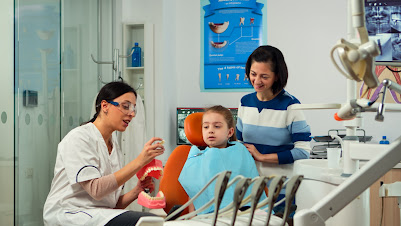 |
| Common Pediatric Dental Procedures |
As parents, we strive to provide the best care for our children's health. From regular check-ups to addressing specific concerns, dental care plays a vital role in maintaining their overall well-being. Understanding common pediatric dental procedures can help ease any anxieties and ensure that you're equipped with the knowledge to support your child's oral health. In this blog, we'll explore some of these procedures and provide insights for parents.
1. Dental Examinations:
Regular dental examinations are essential for identifying potential issues early on and maintaining oral health. During these visits, the dentist will thoroughly examine your child's teeth, gums, and oral tissues. They will also assess the growth and development of your child's teeth, provide oral hygiene instructions, and discuss any concerns or treatment recommendations.
2. Dental Cleanings:
Professional dental cleanings are vital to maintaining a healthy smile. Even with proper at-home oral hygiene practices, plaque and tartar can accumulate in hard-to-reach areas. Dental hygienists will gently remove these deposits, polish the teeth, and offer tips on brushing and flossing techniques tailored to your child's age and needs. Cleanings not only prevent cavities but also leave your child's teeth feeling fresh and clean.
3. Fluoride Treatments:
Fluoride is a natural mineral that helps strengthen tooth enamel, making it more resistant to decay. Fluoride treatments involve applying a concentrated gel or varnish to the teeth. It is a quick and painless procedure that provides added protection against cavities. Your dentist may recommend fluoride treatments based on your child's risk of tooth decay or as part of a preventive regimen.
4. Dental Sealants:
Dental sealants are thin, protective coatings applied to the chewing surfaces of molars and premolars. These back teeth have grooves and crevices that are susceptible to cavities. Sealants act as a barrier, preventing food particles and bacteria from getting trapped and causing decay. The procedure is painless, non-invasive, and can significantly reduce the risk of cavities in these vulnerable areas.
5. Fillings:
If your child has a cavity, a dental filling is typically the most common treatment. The dentist will remove the decayed portion of the tooth and fill the space with a durable and tooth-coloured material. Fillings restore the tooth's function, prevent further decay, and blend seamlessly with the natural tooth structure. Dentists strive to make the process comfortable and pain-free for your child through the use of local anaesthesia or sedation if necessary.
6. Dental X-rays:
Dental X-rays are an invaluable tool for diagnosing oral health issues that may not be visible during a visual examination. They help dentists detect cavities, evaluate the growth of permanent teeth, and assess the development of the jaw and facial bones. Pediatric dental offices prioritize safety by using low-dose digital X-ray machines and taking necessary precautions to protect your child during the procedure.
Conclusion:



.jpg)
No comments:
Post a Comment